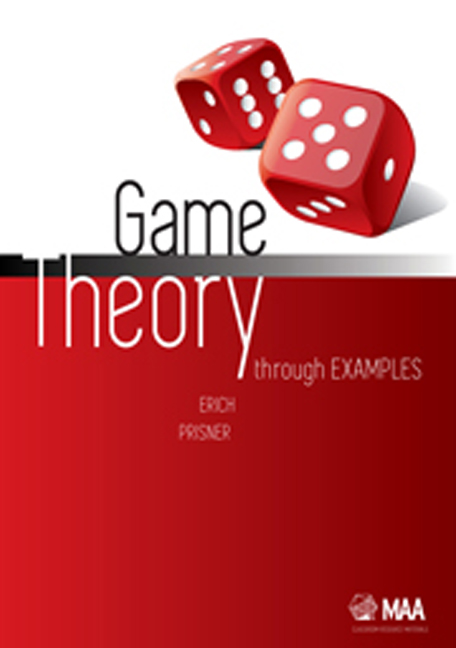Book contents
- Frontmatter
- Contents
- Preface
- 1 Theory 1: Introduction
- 2 Theory 2: Simultaneous Games
- 3 Example: Selecting a Class
- 4 Example: Doctor Location Games
- 5 Example: Restaurant Location Games
- 6 Using Excel
- 7 Example: Election I
- 8 Theory 3: Sequential Games I: Perfect Information and no Randomness
- 9 Example: Dividing A Few Items I
- 10 Example: Shubik Auction I
- 11 Example: Sequential Doctor and Restaurant Location
- 12 Theory 4: Probability
- 13 France 1654
- 14 Example: DMA Soccer I
- 15 Example: Dividing A Few Items II
- 16 Theory 5: Sequential Games with Randomness
- 17 Example: Sequential Quiz Show I
- 18 Las Vegas 1962
- 19 Example: Mini Blackjack and Card Counting
- 20 Example: Duel
- 21 Santa Monica in the 50s
- 22 Theory 6: Extensive Form of General Games
- 23 Example: Shubik Auction II
- 24 Theory 7: Normal Form and Strategies
- 25 Example: VNM POKER and KUHN POKER
- 26 Example: Waiting for Mr. Perfect
- 27 Theory 8: Mixed Strategies
- 28 Princeton in 1950
- 29 Example: Airport Shuttle
- 30 Example: Election II
- 31 Example: VNM POKER(2, r, m, n)
- 32 Theory 9: Behavioral Strategies
- 33 Example: Multiple-Round Chicken
- 34 Example: DMA Soccer II
- 35 Example: Sequential Quiz Show II
- 36 Example: VNM POKER(4, 4, 3, 5)
- 37 Example: KUHN POKER(3, 4, 2, 3)
- 38 Example: End-of-Semester Poker Tournament
- 39 Stockholm 1994
- Bibliography
- Index
19 - Example: Mini Blackjack and Card Counting
- Frontmatter
- Contents
- Preface
- 1 Theory 1: Introduction
- 2 Theory 2: Simultaneous Games
- 3 Example: Selecting a Class
- 4 Example: Doctor Location Games
- 5 Example: Restaurant Location Games
- 6 Using Excel
- 7 Example: Election I
- 8 Theory 3: Sequential Games I: Perfect Information and no Randomness
- 9 Example: Dividing A Few Items I
- 10 Example: Shubik Auction I
- 11 Example: Sequential Doctor and Restaurant Location
- 12 Theory 4: Probability
- 13 France 1654
- 14 Example: DMA Soccer I
- 15 Example: Dividing A Few Items II
- 16 Theory 5: Sequential Games with Randomness
- 17 Example: Sequential Quiz Show I
- 18 Las Vegas 1962
- 19 Example: Mini Blackjack and Card Counting
- 20 Example: Duel
- 21 Santa Monica in the 50s
- 22 Theory 6: Extensive Form of General Games
- 23 Example: Shubik Auction II
- 24 Theory 7: Normal Form and Strategies
- 25 Example: VNM POKER and KUHN POKER
- 26 Example: Waiting for Mr. Perfect
- 27 Theory 8: Mixed Strategies
- 28 Princeton in 1950
- 29 Example: Airport Shuttle
- 30 Example: Election II
- 31 Example: VNM POKER(2, r, m, n)
- 32 Theory 9: Behavioral Strategies
- 33 Example: Multiple-Round Chicken
- 34 Example: DMA Soccer II
- 35 Example: Sequential Quiz Show II
- 36 Example: VNM POKER(4, 4, 3, 5)
- 37 Example: KUHN POKER(3, 4, 2, 3)
- 38 Example: End-of-Semester Poker Tournament
- 39 Stockholm 1994
- Bibliography
- Index
Summary
Prerequisites: Chapters 8, 12, and 16.
Do you gamble at a casino? Would you? Why not? If your answer is that casino games are designed so that the Casino has better odds, you are only partially right. Blackjack is one of the few casino games where playing optimally may actually win you money in the long run. In the last chapter we mentioned some attempts to analyze the game. For those of you eager to go and bankrupt a casino, you will be disappointed to hear that we will not discuss blackjack in detail. There are two reasons. First, casino blackjack is too complicated to treat in an introductory book. Second, and more important, it has a huge extensive form. A similar game called MINI BLACKJACK has most of the essential ingredients of casino blackjack, and it is simple enough for us to analyze. We will see three aspects of casino blackjack, namely counting cards, playing against the house, and reshuffling, in versions of the game.
The Basic Game
The basic game depends on two parameters a and b:
MINI BLACKJACK(a, b) This two-person zero–sum game is played with a shuffled deck of cards containing a known number a of 1s and a known number b of 2s. Ann and Beth, get a card from the top of the deck in front of them face up. A player makes a move by choosing to draw no more cards or to receive another card from the top of the deck. If the player draws another card, it is shown face up. Beginning with Ann, the two players alternate moves unless a player has already chosen to stop drawing cards, in which case the player cannot move anymore. The game ends when both players have stopped. The goal of the game is to have the sum of the player's own cards be 3 or as close to 3 as possible, but not greater than 3. Thus a sum of 3 is best, better than a sum of 2, which is better than a sum of 1, which is better than all other sums (4, 5, or higher). The payoff is 1 for the winner, –1 for the loser, and 0 for a draw.
- Type
- Chapter
- Information
- Game Theory Through Examples , pp. 139 - 148Publisher: Mathematical Association of AmericaPrint publication year: 2014

